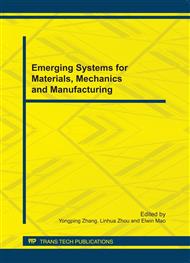[1]
Ye. P. Mamunya, V. V. Davydenko, P. Pissis, E. V. Lebedev, Electrical and thermal conductivity of polymers filled with metal powders, Eur. Polym. J. 38 (2002) 1887-1897.
DOI: 10.1016/s0014-3057(02)00064-2
Google Scholar
[2]
J.W. Wang, X.H. Kong, L. Cheng, and Y.D. He, Inflence of clay concentration on the morphology and properties of clay-epoxy nanocomposites prepared by in-situ polymerization under ultrasonication, J. Univ. Sci. Technol. Beijing, 15 (2008) 320-323.
DOI: 10.1016/s1005-8850(08)60060-2
Google Scholar
[3]
J. Pappas, K. Patel, E. B. Nauman, Structure and properties of phenolic resin/nanoclay composites synthesized by in situ polymerization, J. Appl. Polym. Sci. 95 (2005) 1169-1175.
DOI: 10.1002/app.21303
Google Scholar
[4]
C. K. Lam, K. T. Lau, H. Y. Cheung, Effect of ultra-sound sonication in nanoclay clusters of nanoclay/epoxy composites, Mater. Lett. 59 (2005) 1369-1375.
DOI: 10.1016/j.matlet.2004.12.048
Google Scholar
[5]
X. L. Zhang, L. Shen, X. Xia, H. T. Wang, Q. G. Du, Study on the interface of phenolic resin/expanded graphtie composites prepared via in situ polymerization, Mater. Chem. Phys. 111 (2008) 368-374.
DOI: 10.1016/j.matchemphys.2008.04.028
Google Scholar
[6]
T. S. Chung, Y. J. Lan, Y. Li, Santi Kulprathipanja, Mixed matrix membranes comprising organic polymers with dispersed inorganic fillers for gas separation, Prog. Polym. Sci. 32 (2007) 483-507.
DOI: 10.1016/j.progpolymsci.2007.01.008
Google Scholar
[7]
F. EI-Tantawy, K. Kamada, H. Ohnabe, In situ network structure, electrical and thermal properties of conductive epoxy resin-carbon black composites for electrical heater applications, Mater. Lett. 56 (2002) 112-118.
DOI: 10.1016/s0167-577x(02)00401-9
Google Scholar
[8]
W. Zhang, Richard S. Blackburn, Abbas A. Dehghani-Sanij, Effect of solid particle loading on nucleophilic addition of epoxy-resin to isophorone diisocyanate, China Particuology, 6 (2007) 949-951.
DOI: 10.1016/j.cpart.2007.10.005
Google Scholar
[9]
H. S. Jeon, J. K. Rameshwaram, G. Kim, Characterization of polyisoprene-clay nanocomposites prepared by solution blending, Polymer 44 (2003) 5749-5754.
DOI: 10.1016/s0032-3861(03)00466-x
Google Scholar
[10]
Adbelaziz Bouazizi, Albert Gourdenne, Interaction between carbon black-epoxy resin composites and continuous microwaves-I. Electrical power dependence of the rate of crosslinking of the epoxy matrix, Eur. Polym. J. 24 (1988) 889-893.
DOI: 10.1016/0014-3057(88)90164-4
Google Scholar
[11]
M. Nakahara, T. Takada, H. Kumagai, Y. Sanada, Surface chemisty of carbon black through curing process of epoxy resin, Carbon 33 (1995) 1537-1540.
DOI: 10.1016/0008-6223(95)00099-y
Google Scholar


